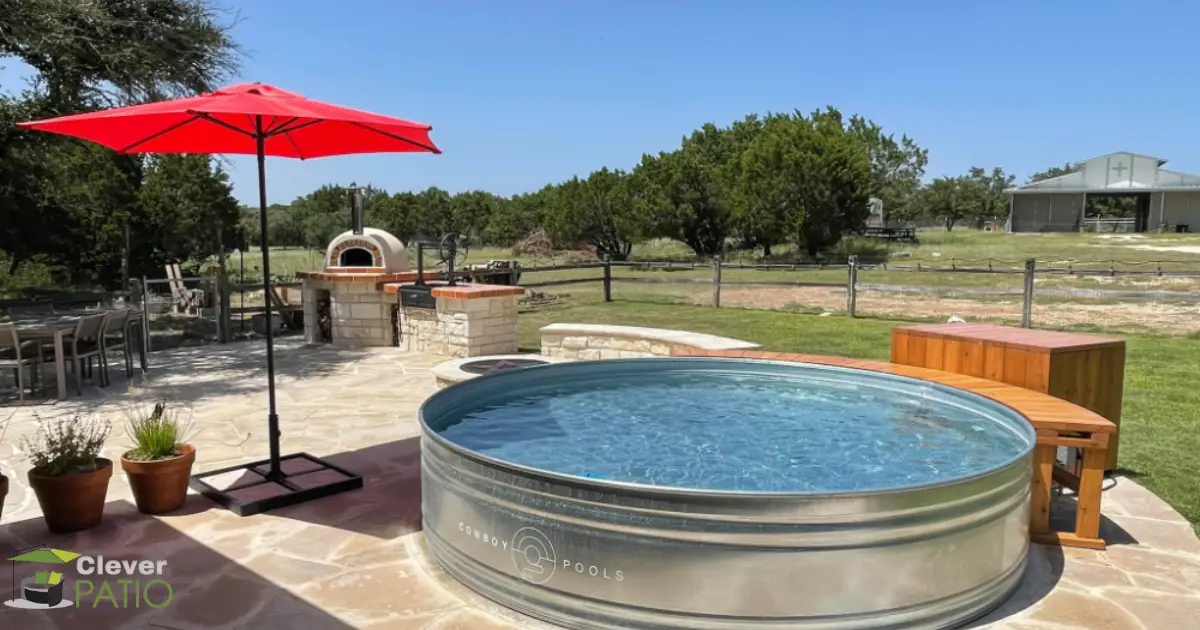
The first step to extend a patio without concrete is understanding what the finished look will be. If you are able to visualize your end result, it can help with planning and decision-making throughout construction.
Whether or not you want brick pavers laid out in a particular way, plants added for landscaping, or unique furniture placed on the patio should all factor into your plans before breaking ground.
How To Extend a Patio Without Concrete
Pouring concrete can get expensive because contractors and permits are needed. An alternative to more patio space is extending your patio with pavers, which cost a lot less.
Benefits of using Patio Pavers
- You don’t have to be experienced in installing building materials because all you need are some basic tools like hammers and saws; installation only takes one day tops.
- Pavers allow homeowners a large variety of shapes, sizes, colors, and materials to use for their patio.
- Pavers can be used to create a larger or smaller patio, as well as make the space more formal or informal.
- Less expensive than other options, and can still give you an instant upgrade on the appearance of your outdoor living space by providing a clean modern look for your backyard with its sleek finish.
Steps How To Extend a Patio Without Concrete

1. Planning
The first step is to lay out your patio pavers and make sure they are going in a straight line.
If you want, you can also use chalk as an easy way of making it easier for yourself! Next, we will need to put down some stakes every 18 inches (or so) away from our finished endpoint with enough room to hammer them into the ground.

2. Get Enough Pavers
To calculate the number of pavers needed for a new patio, square and rectangular patios will require enough material to cover the new space plus approximately 5%.
Irregularly shaped patios will require more cuts so an additional 10% should be purchased.
3. Map Out Your Patio Area
Outline the outline of where the patio will go by using string or a garden hose. The base should extend beyond the guard roughly as wide as a paver for stability and it needs to be at least 4”-6” in width.

4. Create A Slope
The most important part of laying pavers is preparing to slope away from an existing patio.
This will prevent pooling and create a drainage system that works far more efficiently. The slopes should be at least 1/8” over one foot, or ¼” for even better drainage.

5. Excavating
Determining the depth of excavation relies on three things: how high your paving stones are; if the soil is wet or dry; and, whether it’s a sloped surface.
A five-inch base layer is standard for most residential projects.
If, however, your property’s soil is highly mossy, swampy, or steep then you want to excavate 12 inches deep at a minimum.
Once the excavation is complete, strings can be run from stakes at the existing patio to the front of the planned patio area and adjusted so they show the slope.
In addition, strings should also be run crossways to ensure that pavers are level across the entire new area.

6. Base Material
The base is usually a crushed rock material laid by hand on the ground. 2 inches should be added at a time with each layer compacted after so that the installation holds weight effectively.
A compactor is not necessary if working in small to medium projects, but can be rented for larger areas of installation.
Lay the base material 2 inches thick. Then water it to help with the compaction. Add more of the base material until you have reached the desired height for your base.
Be sure to work in manageable increments and make sure that you are creating a stable frame for your pavers around the edges.
7. Insert Edge Restraints
Edging has three main purposes:
-to hold pavers in place by holding them against the vertical sections.
-to establish clean edges for your project.
-to act as a filler where there is no vertical section or at curves to help create a neat, even appearance

8. Add Your Sand Layer
The sand in a patio acts as a binder. A wide-mouth paver should be power troweled to the desired height, no more than an inch and a half thick.
To screed a small section, use the 2×4 trick; for large projects, lay down aluminum pipes to measure out sections before removing them after one is finished.
The groove left behind should also be filled in and leveled with a power trowel or by hand.

9. Lay The Pavers
The best way to lay the pavers is by starting in one corner and working your way out. It’s important that you start laying them from a bottom corner so they don’t shift; it can be frustrating if some of the slabs are sticking up too high, or not sitting flat against each other.
Once you have laid two rows of tiles with enough space for grouting, pour on as much water as possible before moving onto the next row.
If you have any cuts or crevices where there was an error in measurement, fill these gaps with mortar and then put down another layer of paving slab before finishing off with sand over top.
The patio should be left for a week or so, allowing enough time for the grouting process to harden. Once this has happened, sweep up any excess sand with a broom then rinse off the area with water.
After doing this four times over two weeks in order to wash away all of the remaining residues from the pooling water, your pavers are now fully protected against water damage as well as being easier to clean when necessary.

10. Tamp It Down
Removing dirt and compaction from pavers before using a tamper is important for many reasons.
One of the most obvious benefits that you’ll see after removing the dust layer on your patio stones is increased light reflection, enhanced color appearance, more uniform stone surface texture, and reduced weed growth.
Finish your patio by sweeping sand into joints between each surrounding paver. This will lock the pavers together.

11. Sealing Your Patio Pavers
A quality sealing product like DOMINATOR LG+ will provide protection from water damage that causes rusting or bubbling up underneath your paving slabs.
It also provides protection against UV rays which break down the material over time causing cracks in the coloration of the cement blocks.
It penetrates into pores on dirt particles making them easier to remove, keeping your patio surface cleaner and free of weeds.
A quality sealant also provides protection from dirt, dust, grime, mud as well as water damage that can happen during the winter months when the snow melts.
Not only does it protect against outside forces but this type of product will help keep mold and mildew away which makes it easier to clean up spills before they dry out too much.
How much does patio pavers cost?
To install most pavers, expect to pay an average of $8-$25 per square foot. Preparing the ground and installing the pavers can be a time-intensive process.
Is it cheaper to lay concrete or pavers?
Concrete is the most affordable option for flooring, coming out at a cost of $1.75 per square foot.
This relatively low price point comes with significant trade-offs, however.
The upfront cost of installing concrete pavers is higher than poured concrete and stamped concrete, while the durability margin falls short as well when compared to these more expensive options.
How much does a 20×20 patio cost?
According to HomeGuide, a 20×20′ paver patio will cost about $1,900-6,800 including labor and materials.
The more expensive the material (natural stone vs clay bricks) and the larger your yard arrangement is (e.g., if you have an L shape instead of a straight row), the more it’ll cost.
Can I just lay pavers on dirt?
Yes, of course, you can install pavers on dirt. If the ground is compacted and stable enough to support your weight then it will be fine for a paver installation as well.
There are some considerations that need to be taken into account when installing over unpaved surfaces though:
1. The surface must have sufficient drainage so water doesn’t pool up at any point during heavy rainfall events. Paving stone needs space below them in order for them not to get wet or slip around.
That means if there’s too much rainwater sitting stagnant on top of the stones they may start sliding all over the place! This is also why we always recommend using sand as an underlayment rather than soil because it allows more room underneath which keeps the pavers in place.
2. The ground must be stable and will need to have a good base for the stones to sit on which could include concrete or sand, depending on what you’re installing over.
If it’s unpaved soil then this is especially important because dirt can shift or blow away during windy weather events! We recommend using both if possible.
3. The surface should also be level since paving stones are traditionally set upon an even plane with no slopes between them so they don’t fall off of one another when walked on by foot traffic.
That means that if there isn’t enough space underneath the pavers (or any slope) then your installation may not work out too well at all! It might end up looking like a pile of stones at the end that is prone to slipping or caving.
Conclusion
In conclusion, if you want to extend your patio without the concrete and have a little more space for entertaining or playing with the kids in your yard, then hopefully this article helped you.
We’ve outlined all the steps involved so that you can make an informed decision on how to proceed.
By following these instructions carefully and making sure to take into account any safety concerns of yours, we hope that you are able to build your own extension at home!




Leave a Reply